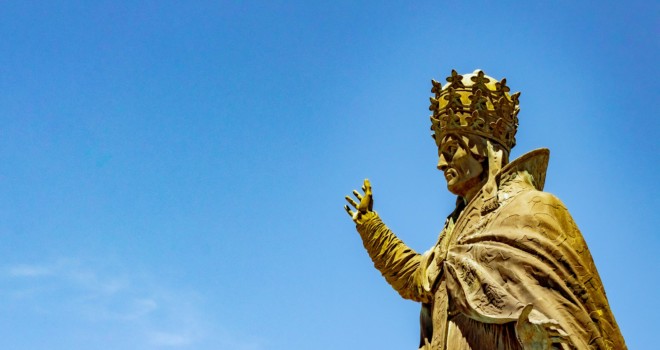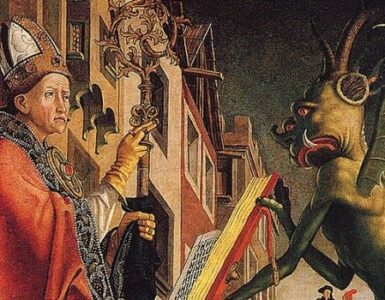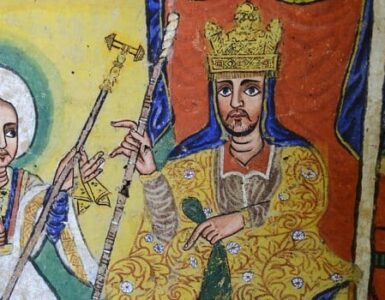Dear Father: When visiting the Basilica of the National Shrine of the Immaculate Conception I saw the papal crown of Pope Paul VI. Do the popes still wear this crown? I don’t remember seeing Pope John Paul II ever wearing it.
The papal crown, or tiara, was traditionally worn by the popes of the past few centuries until the pontificate of Pope John Paul I. Like many ceremonial items, the papal tiara developed over time. Since the pope is also the Bishop of Rome, the successor of St. Peter, he wears a mitre for liturgical ceremonies; some historians posit that this custom originated in the apostolic times. However, since the pope is also the pastor of the universal Church, some kind of headdress was adopted to be worn outside of liturgical functions which would highlight his authority.

The papal tiara is first mentioned in the account of the life of Pope Constantine (708-715) in the Liber Pontificalis. Here it is called a camelaucum, which was part of the Byzantine court dress. At this time, it was constructed more like a “papal cap” made of white cloth. Pope St. Gregory the Great (d. 604) was depicted in artwork wearing such a cap.
Sometime shortly after the ninth century, an ornamented circlet (or banding) was added to the base of the cap. Whether this circlet was for decoration or to represent a crown remains uncertain. Since the pope held not only spiritual authority over the whole Church but also temporal authority over the Papal States, a crown would not be necessarily inappropriate. Coins with the image of Pope Sergius III (904-11) and Pope Benedict VII (974-983) depict these popes wearing a helmet-like-cap with such decoration.
The first usage of the actual word “tiara” is found in the life of Pope Paschal II (1099-1118) in the Liber Pontificalis. Around the mid-1200s, the ornamented circlet on the tiara became a highly decorated, tooth-edged crown. Also, on the back there were added two caudae or fans (two strips of cloth hanging from behind, similar to those attached to a bishop’s mitre). Some suggest that these fans originated from the sweatband that a Greek athlete wore, which was wrapped around the forehead, tied behind the head in a knot with the two ends hanging down the back; since the victorious athlete was crowned with a laurel wreath, the whole headdress soon was seen as a sign of victory. Consequently, these fans had a symbolic meaning, arising from St. Paul’s analogy: “I have fought the good fight, I have finished the race, I have kept the faith. From now on a merited crown awaits me…” (2 Tm 4:7-8).
Pope Boniface VIII (1294-1303), who tried to re-exert papal authority over the rising secular monarchs, added a second crown to show his spiritual and temporal jurisdiction. Sometime after the pontificate of Pope Boniface VIII and before the death of Pope Benedict XII (1334-1342), a third crown was added. Especially during the Renaissance, the tiaras became more and more elaborate, embellished with jewels.
Several rationales exist for the papal tiara formed by three crowns, thereby called the triregno: First, the crowns represent the pope’s universal office, his jurisdiction over the whole Church, and his temporal power. A second rationale is that the three crowns symbolize the pope’s authority over the Church militant on earth, the Church penitent in purgatory and the Church triumphant in heaven. Another rationale, which is most dominant today, is that the pope is the Vicar of Christ, who shares in His three-fold office of Priest, Prophet and King, and consequently shares in His work to sanctify, teach and lead others in the faith.
To this day, a papal tiara may still be used. Pope Paul VI, the last pope to use a papal tiara, issued his apostolic constitution “Romano Pontifici Eligendo” (1975) which updated the regulations concerning the election of a new pope. According to these regulations, after the election of a new pope, a “coronation” would follow: “Finally, the new pontiff is to be crowned by the senior cardinal deacon” (No. 92). Afterward, “within a suitable period, he is also to take possession, in the prescribed manner, of the Patriarchal Archbasilica of the Lateran.”
However, Pope John Paul I (1978) declined the use of a tiara as did his successor, Pope John Paul II (1978-2005). Instead, at the beginning of the “solemn inauguration,” the pallium was placed over their shoulders. The pallium is a strip of white wool decorated with six black crosses that is worn around the neck like a collar, over the chasuble, with two strips, one hanging down the front and one hanging down the back. Predating Christianity, the Church adopted the pallium, viewing it as a sign of fidelity to Christ. The Holy Father, Metropolitan Archbishops and the Patriarch of Jerusalem wear a pallium as a sign of their service and their authority.
In 1996, when Pope John Paul II again updated the regulations concerning the election of a new pope, he modified the language: “After the solemn ceremony of the inauguration of the pontificate and within an appropriate time, the pope will take possession of the Patriachal Archbasilica of the Latern, according to the prescribed ritual” (“Universi Dominici Gregis,” No. 92). While the papal tiara has not been formally suppressed, perhaps its time has passed.
Whatever vestiture is used to represent the office of the Holy Father, what is most important is that it represents the service and fidelity of the Vicar of Christ to our Lord and to the Church. Pope John Paul II prayed at his own inauguration, “Christ, make me become and remain the servant of your unique power, the servant of your sweet power, the servant of your power that knows no eventide. Make me a servant. Indeed, the servant of your servants.” So the tiara or pallium is not made to fit the man, but the man must strive to fit them.
(This article courtesy of the Arlington Catholic Herald.)












